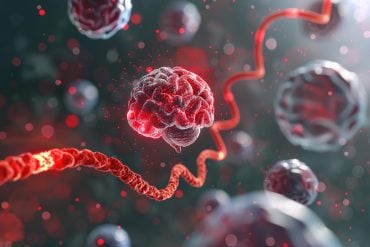Summary: Scientists discovered that rats intensify their memories of negative experiences in familiar places by repetitively replaying them. This mental map, generated by specific neurons known as place cells, can be altered when the animal encounters a negative experience.
The researchers found that the place cells associated with the negative experience were selectively reactivated during rest periods. This breakthrough could lead to novel treatments for psychiatric disorders like post-traumatic stress disorder (PTSD).
Key Facts:
- Rats reinforce their memories of negative experiences in familiar locations by replaying them in their minds.
- The neurons where negative experiences are stored are separate but adjacent to the place cells in the hippocampus.
- The research could potentially contribute to the development of new treatments for psychiatric disorders like PTSD, by improving understanding of how the brain processes and recalls traumatic experiences.
Source: RIKEN
Three RIKEN neuroscientists have found that rats reinforce the memories of negative experiences in familiar locations by preferentially replaying them over in their minds.
This finding could have implications for treating conditions in people such as post-traumatic stress disorder (PTSD).
When an animal explores a new place, it generates a mental map of the area, which it can later recall. This mental map is created by special neurons known as place cells, which reside in the hippocampus.
Different place cells fire as the animal moves around the area, but when it returns to a spot it has visited before, the same place cell fires again.
This mapping mechanism is well understood now, but it wasn’t clear how animals incorporate memories of things that happen to them while revisiting a previously mapped-out location.
Significant events get burned in our memories along with the place where they happened, whereas we tend to forget about details that don’t matter.
“For example, if you’re hiking along a familiar trail, you’re probably not going to remember all the details of the trail,” says Joshua Johansen of the RIKEN Center for Brain Science.
“But if a bear comes out and attacks you, you’re going to remember a lot of the details about the bear and also the surrounding environment. We want to understand how these more complex memories are formed.
Now, Johansen, along with Jake Ormond and Simon Serka, has found that the neurons where negative experiences are stored are separate but adjacent to the place cells in the hippocampus and that the memories are reinforced by replaying the experience.
Their work is published in The Journal of Neuroscience.
Specifically, the team found that a specific population of place cells “remapped,” changing their firing location to reflect the aversive experience, while other place cells did not change their firing location during learning, providing a stable representation of the physical environment.
Notably, the cells associated with the negative experience were preferentially reactivated during rest periods between trials.
This finding could inform the development of new treatments for psychiatric disorders such as PTSD.
“We’ve made much headway in understanding how simple forms of learning such as fear conditioning occur,” notes Johansen.
“But that hasn’t really brought us that much closer to being able to treat conditions such as PTSD.”
This might be because we lack a good understanding of the higher-order processing systems in the brain that are altered in PTSD, Johansen thinks.
“Understanding how higher-order systems such as the hippocampus alter the record of unpleasant experiences could give basic insights into how these systems are altered and dysregulated in conditions such as PTSD,” he says.
About this memory and PTSD research news
Author: Joshua Johansen
Source: RIKEN
Contact: Joshua Johansen – RIKEN
Image: The image is credited to Neuroscience News
Original Research: Open access.
“Enhanced Reactivation of Remapping Place Cells during Aversive Learning” by Joshua Johansen et al. Journal of Neuroscience
Abstract
Enhanced Reactivation of Remapping Place Cells during Aversive Learning
Study of the hippocampal place cell system has greatly enhanced our understanding of memory encoding for distinct places, but how episodic memories for distinct experiences occurring within familiar environments are encoded is less clear.
We developed a spatial decision-making task in which male rats learned to navigate a multiarm maze to a goal location for food reward while avoiding maze arms in which aversive stimuli were delivered. Task learning induced partial remapping in CA1 place cells, allowing us to identify both remapping and stable cell populations.
Remapping cells were recruited into sharp-wave ripples and associated replay events to a greater extent than stable cells, despite having similar firing rates during navigation of the maze.
Our results suggest that recruitment into replay events may be a mechanism to incorporate new contextual information into a previously formed and stabilized spatial representation.







